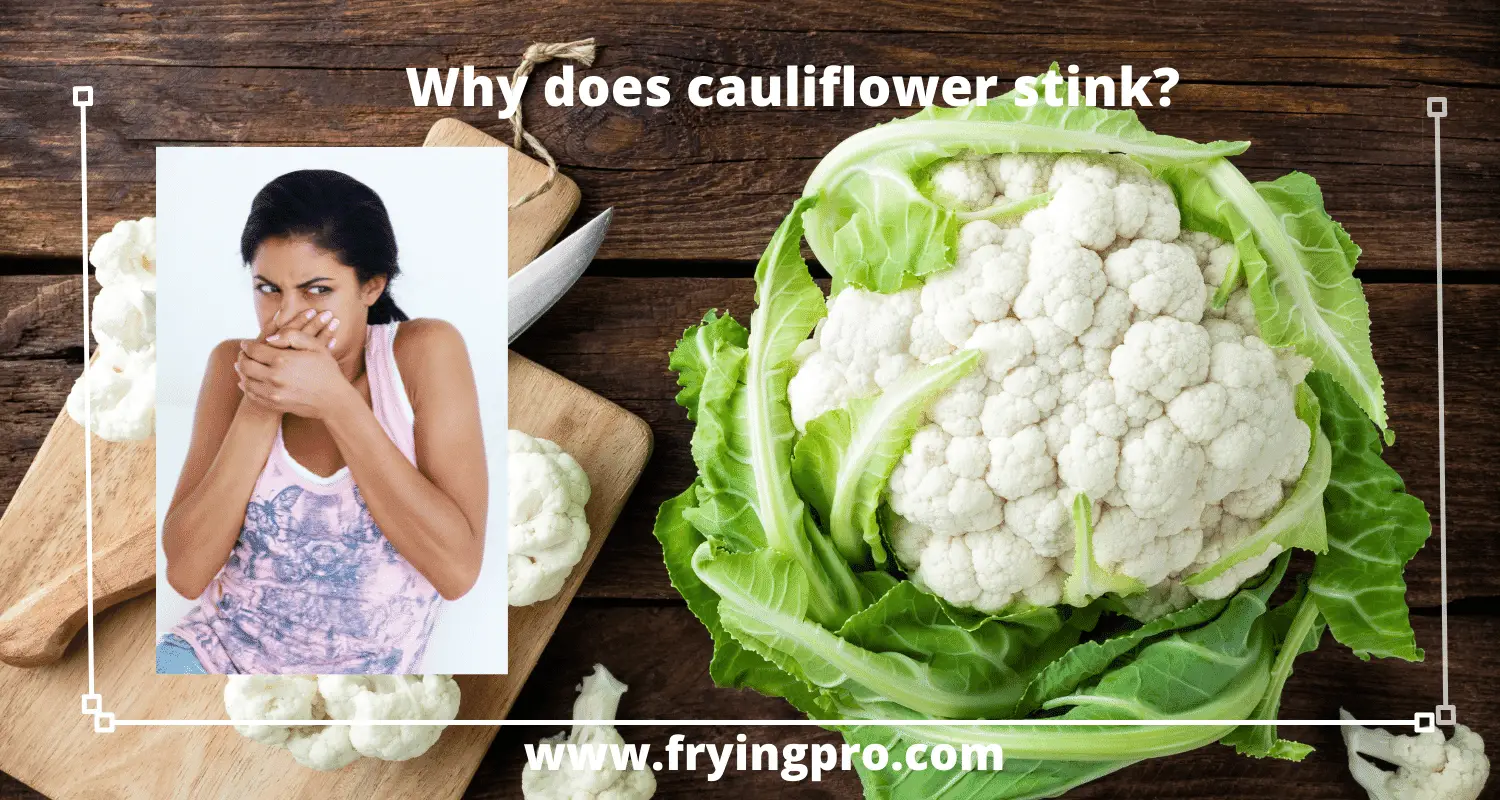Cauliflower is one of the most widely eaten vegetables out there. But have you ever wondered where the pungent smell in this vegetable comes from Why does Cauliflower stink?
This blog post will help you find an easy scientific explanation and proven methods to cook Cauliflower without any smell.
Table of Contents
- Why does Cauliflower stink?
- What is the nutritional composition of Cauliflower?
- Is it OK to eat smelly cauliflower?
- How do you keep cauliflower from smelling?
- How do you keep cauliflower from smelling in the fridge?
- How do you get gas out of cauliflower?
- How to cook Cauliflower without the smell?
- Conclusion
Why does Cauliflower stink?
Cauliflower has a pungent smell due to Sulphur-containing amino acids (SSA), i.e., methionine and cysteine. SSA releases an unpleasant smell when cooked. This smell can be reduced by shorter cooking periods. Cauliflower has the 2nd highest SAA content, making it one of the most pungent among all the Cruciferous vegetables.
A study published in Food Chemistry on 2017 showed that Cruciferous vegetables such as Cauliflower have a significant amount of dietary sulfur in the form of Sulphur-containing amino acids (SAA), and methionine and cysteine.
Due to these amino acids, a pungent smell is released during cooking and even after consuming it, in the form of farts. The study revealed that cruciferous vegetables contribute 37.9% of the daily sulfur intake of an average person.
| Vegetables | SAA µmoles/g dry weight | (% of total Sulphur) |
| Kale | 49.4 | 16 |
| Cauliflower | 44.3 | 22.3 |
| Cabbage | 28.5 | 28.9 |
| Green Pepper | 19.5 | 34.4 |
Cauliflower is a great vegetable because it can be seasoned and cooked in many different ways. However, it also has its downsides when it comes to flavor.
Related: How long can cauliflower last in the fridge?
What is the nutritional composition of Cauliflower?
Cauliflower is a low-calorie, nutrient-dense food that provides vegetable protein, vitamin C, and antioxidants. It’s also incredibly versatile.
You can add it to soups and stews, make mashed cauliflower as a substitute for potatoes or rice, or even try it in a spicy curry.
Cauliflower is high in fiber and contains around 31 percent of the daily recommended iron content. It also has less than one gram of fat per cup of raw cauliflower!

Is it OK to eat smelly cauliflower?
Although cauliflower has a bad smell, it is still perfectly safe to eat.
You just need to cook it until the smell goes away. You can cook cauliflower in many different ways: –
- If you want to cook the cauliflower in water and add seasonings, use around two teaspoons of salt, one teaspoon of pepper, and two tablespoons of sauce.
- If you want to steam the cauliflower over a pot on the stovetop, use about 6 cups of water. Put vegetables inside the steamer basket for about 10 minutes or until soft and tender.
- If you want to bake the cauliflower in an oven with olive oil, use 2 teaspoons of salt and 3 tablespoons of olive oil. Put everything into a dish with no holes or gaps too tightly. Bake at 350 degrees Fahrenheit for around 30 minutes or until browned on top.
- If you’re cooking in a pan on the stovetop, heat up vegetable oil over medium heat while adding onions and garlic if desired before adding other ingredients such as carrots and potatoes once they are cooked thoroughly.
How do you keep cauliflower from smelling?
To avoid the smell, you simply need to rinse your freshly cut or grated cauliflower in cold water and then pat dry with a paper towel. This will prevent any of the odor-causing chemicals from sticking to the fruit.
Of course, if you’re not willing to cook with cauliflower, there are still other ways it can be used as a dish on its own.
Cauliflower is an excellent source of vitamin C and fiber, so it’s always great for a healthy diet when eaten whole as a vegetable or mashed into a side dish.
Read: Does Spicy Food Last Longer in The Fridge?
How do you keep cauliflower from smelling in the fridge?
There are specific ways to keep cauliflower from smelling during storage.
Some of the most successful methods include:
- Freezing it for up to 3 months
- Wrapping it in aluminum foil before freezing
- Storing it in a sealed plastic bag
These methods will help prevent harmful bacteria from growing and causing the vegetable to spoil. They will also stop other foods around from getting the odor as well.
If you don’t want to take these extra steps, one way to reduce the smell of aging cauliflower is to grate it and sprinkle salt on top until it tastes fresh.
This method ensures that the freshest taste is apparent in every bite.
How do you get gas out of cauliflower?
Cauliflower has to be rinsed thoroughly before using it in another dish. One way to make the cauliflower more palatable is by cooking it with garlic and parsley. This will help eliminate some of the smell, but you will still have to rinse it again before using it in the next dish.
Another way to get rid of the smell is by placing a towel on top of the head of cauliflower and squeezing out as much gas from the cauliflower as possible.
Another way is by putting them in a bowl and covering them with a plastic bag for about 20 minutes. The bag should be sealed tightly and then removed once finished. At this point, you can rinse them off and remove any remaining gas that may still be trapped inside.
Read: Does Frozen Meat Weigh More?
How to cook Cauliflower without the smell?
The only good way to avoid the smell is to cook cauliflower in a water solution. Unlike cabbage, you can cook your cauliflower in a pot of boiling water and then simmer it for 15-20 minutes. The hot water will remove most sulfur-containing chemicals, and the odor will disappear.
Conclusion
So, why does Cauliflower stink? Cauliflower is a vegetable with a strong smell that can overpower some people. It’s important to note that it is not the cauliflower that causes the smell but rather the sulfur in the cauliflower. The smell is caused by a reaction between the sulfur and oxygen in the air.







